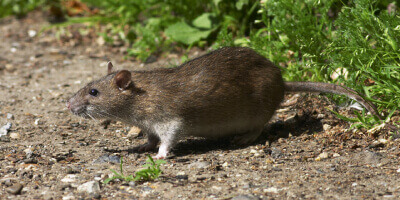Rat Facts & Information
Everything you need to know about rats
WHAT DO rats LOOK LIKE

Norway rats are easily identifiable by their coarse brown fur and large size. Adults can weigh about 1/2 to 1 pound. From nose to tail, they measure over 15 inches long. The brown fur of the Norway rat lightens toward the underside. Despite its large size, its eyes and ears are small. The tail and ears are not covered in fur but that skin resembles a scaly texture.
Norway rats may be difficult to observe within a home or building, since they’re nocturnal in nature. However, their droppings are often visible in homes they inhabit. These droppings measure about 3/4 of an inch in length and are capsule-shaped, with blunt ends.
Norway rats tend to line their nests with shredded paper, cloth, and other fibrous material. Outside burrows are made up of complex, underground networks with multiple exit holes. This burrowing behavior allows Norway rats access to outside food sources such as garbage cans or bird feeders while still having the shelter they need to survive.
Norway rats may be difficult to observe within a home or building, since they’re nocturnal in nature. However, their droppings are often visible in homes they inhabit. These droppings measure about 3/4 of an inch in length and are capsule-shaped, with blunt ends.
Norway rats tend to line their nests with shredded paper, cloth, and other fibrous material. Outside burrows are made up of complex, underground networks with multiple exit holes. This burrowing behavior allows Norway rats access to outside food sources such as garbage cans or bird feeders while still having the shelter they need to survive.
Where Are Rats Found
Norway rats are most commonly burrowers. They build their nests outside the walls of homes or in various clumps of vegetation. Norway rats may also construct their homes beneath the edges of sidewalks or patios. Keep in mind they are opportunistic, so they will build their nest in their preferred spots while keeping their little rat brains open to anywhere with their three major needs: shelter, water, and food. Norway rats are the most common species in Massachusetts, Connecticut, New York, Maine, Vermont, New Hampshire, and Rhode Island, but if you’ve ever seen a rat, you probably, you don’t really care what kind of species the rat is. You just want it gone.
How Did I Get Rats
Rats are fairly opportunistic feeders. They will feed on just about anything including carcasses and fallen fruit. Human environments provide them an abundance of resources and make entering you home or business an easy decision. Particular species of rat may have tendency for certain foods. Norway rats often prefer foods high in protein such as meat scraps or pet food. If you have anything like that in your home or business’s pantry, shed, or garage, then you can easily get Norway rats. They only need a hole the size of a quarter to squeeze through even though they can grow quite large, so it doesn’t take an open door to let them in.
When living near humans, the availability of foods will drive a rodent’s habits. They often will travel outdoors and indoors searching for nutrition. They can take advantage of many food sources such as garbage cans, open containers of food, pet food bowls, and they will even cannibalize their own dead.
When living near humans, the availability of foods will drive a rodent’s habits. They often will travel outdoors and indoors searching for nutrition. They can take advantage of many food sources such as garbage cans, open containers of food, pet food bowls, and they will even cannibalize their own dead.
What Problems Do Rats Cause
Rats are notoriously disgusting pests. The problems they can cause in homes and businesses is a rather long list. Rat bites and scratches can result in disease and rat-bite fever. Rat urine is responsible for the spread of leptospirosis, which can result in liver and kidney damage. It can also be contracted through handling or inhalation of scat. Complications include renal and liver failure, as well as cardiovascular problems.
Lymphocytic choriomeningitis (LCMV), a viral infectious disease, is transmitted through the saliva and urine of rats. Some individuals experience long-term effects of lymphocytic choriomeningitis, while others experience only temporary discomfort. One of the most historically dangerous rat-borne diseases is the bubonic plague, also called “Black Plague,” and its variants. Transfer occurs when fleas from the rats bite human beings. Fleas transported on rats are considered responsible for this plague during the Middle Ages, which killed millions. From the transmission of bubonic plague to typhus and hantavirus, rat infestations can prove harmful to human health. One disease that is directly transmitted by rats is Hantavirus Pulmonary Syndrome. This disease is spread in one of three ways: inhaling dust that is contaminated with rat urine or droppings, direct contact with rat feces or urine, and infrequently due to the bite of a rat. Victims may be debilitated and can experience difficulty breathing. Hantavirus is transmitted to humans when they inhale airborne particles from rodent droppings, urine or carcasses that have been disturbed. The first symptoms of the virus can be mistaken for the flu. Patients then suffer breathing difficulties that may prove fatal if not treated effectively and immediately.
Rats also are a potential source of allergens. Their droppings, dander, and shed hair can cause people to sneeze and experience other allergic reactions and can even induce asthma attacks. In addition, rats also cause structural damage, leaving unsightly holes in lawns, undermining building foundations, and gnawing through electrical wiring, causing power outages and electrical fires. They also leave teeth and rub marks on the walls.
Lymphocytic choriomeningitis (LCMV), a viral infectious disease, is transmitted through the saliva and urine of rats. Some individuals experience long-term effects of lymphocytic choriomeningitis, while others experience only temporary discomfort. One of the most historically dangerous rat-borne diseases is the bubonic plague, also called “Black Plague,” and its variants. Transfer occurs when fleas from the rats bite human beings. Fleas transported on rats are considered responsible for this plague during the Middle Ages, which killed millions. From the transmission of bubonic plague to typhus and hantavirus, rat infestations can prove harmful to human health. One disease that is directly transmitted by rats is Hantavirus Pulmonary Syndrome. This disease is spread in one of three ways: inhaling dust that is contaminated with rat urine or droppings, direct contact with rat feces or urine, and infrequently due to the bite of a rat. Victims may be debilitated and can experience difficulty breathing. Hantavirus is transmitted to humans when they inhale airborne particles from rodent droppings, urine or carcasses that have been disturbed. The first symptoms of the virus can be mistaken for the flu. Patients then suffer breathing difficulties that may prove fatal if not treated effectively and immediately.
Rats also are a potential source of allergens. Their droppings, dander, and shed hair can cause people to sneeze and experience other allergic reactions and can even induce asthma attacks. In addition, rats also cause structural damage, leaving unsightly holes in lawns, undermining building foundations, and gnawing through electrical wiring, causing power outages and electrical fires. They also leave teeth and rub marks on the walls.
How Can I Prevent Rats
Preventing rats is doable. Having professional exclusion work done to close up any cracks and crevices they can squeeze through is your first step. Be sure to fix leaky faucets that can cause excess moisture that can cause one of the attractants rats need to live (water). Be sure your pantry items, including pet foods, are stored in air tight containers and that your trash cans are covered tightly. If you can smell your garbage, then considering how good their sense of smell is, they can smell it from a far ways away! That will certainly attract them. Keeping your trash cans clean and tightly closed can help remove that attractant.
Besides keeping your trash areas clean, basic sanitation practicing like keeping food preparation areas clean and cleaning up spills and crumbs immediately will not just help prevent rats, but cockroaches, flies, and ants. Unfortunately, bird feeders can attract rats, squirrels, and even bear in the right areas of Pennsylvania and New Jersey. So keep that in mind if you’re thinking of getting one. Good landscaping practices can also help including trimming back vegetation from building exterior and removing any standing water outside (sorry bird baths).
Besides keeping your trash areas clean, basic sanitation practicing like keeping food preparation areas clean and cleaning up spills and crumbs immediately will not just help prevent rats, but cockroaches, flies, and ants. Unfortunately, bird feeders can attract rats, squirrels, and even bear in the right areas of Pennsylvania and New Jersey. So keep that in mind if you’re thinking of getting one. Good landscaping practices can also help including trimming back vegetation from building exterior and removing any standing water outside (sorry bird baths).
Why Waltham for Rat Control
We’re passionate about keeping rats out of your home or business because we live and work here – it’s our neighborhood, too. With our 130 years of experience keeping homes and businesses in Massachusetts, Connecticut, New York, Maine, Vermont, New Hampshire, and Rhode Island safe from pests, Waltham has the experience you can trust.
Satisfaction Guarantee
24-Hour Guaranteed Response
Board Certified Entomologists
Consider rats controlled.
GET MY QUOTE
“Exceptional service. Prompt and professional. Used for both business and home. Very efficient and honest.”
Agawan, MA
